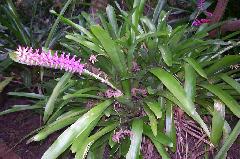
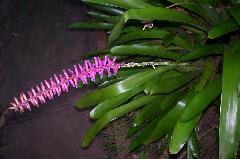
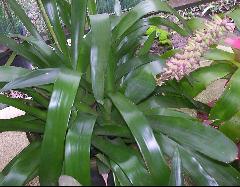
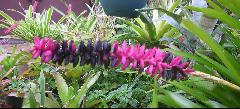
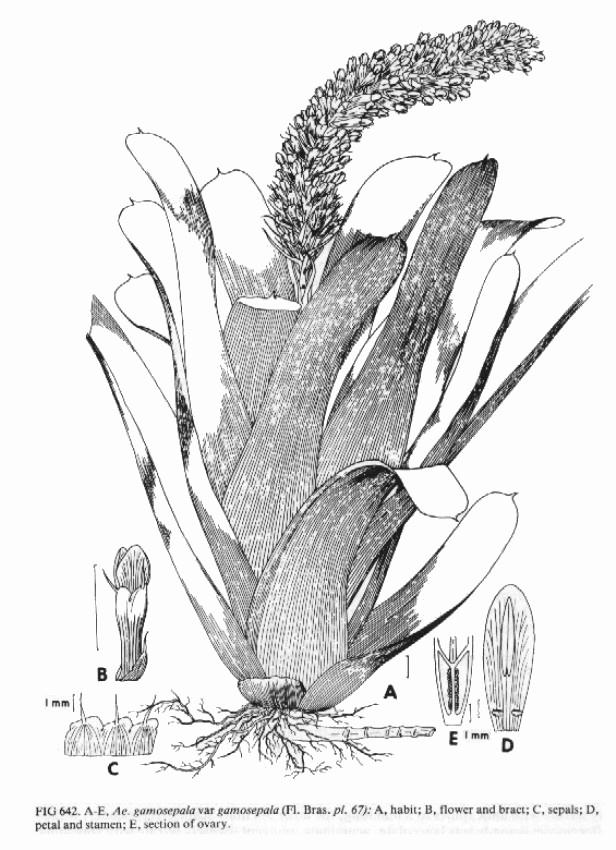
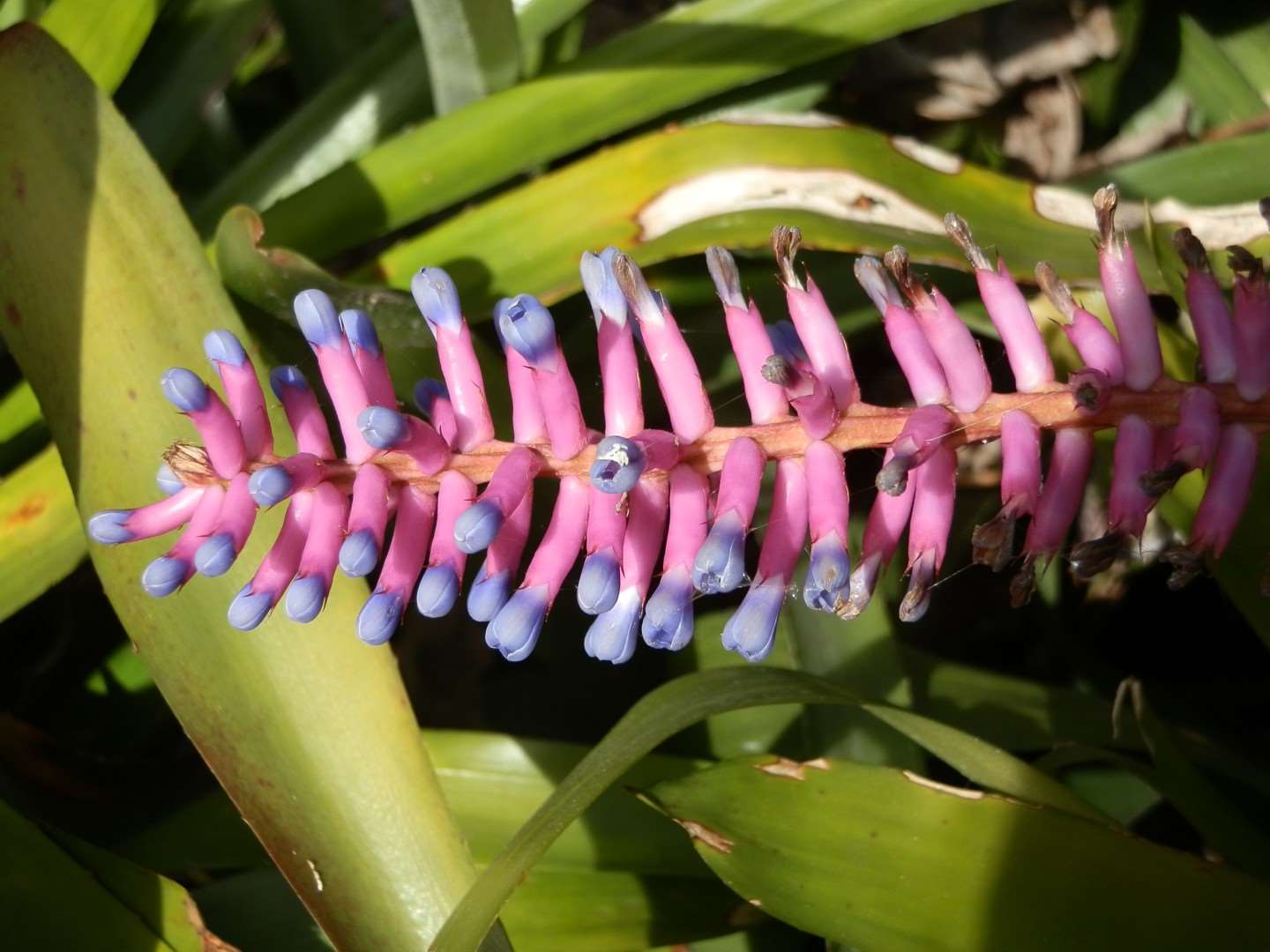
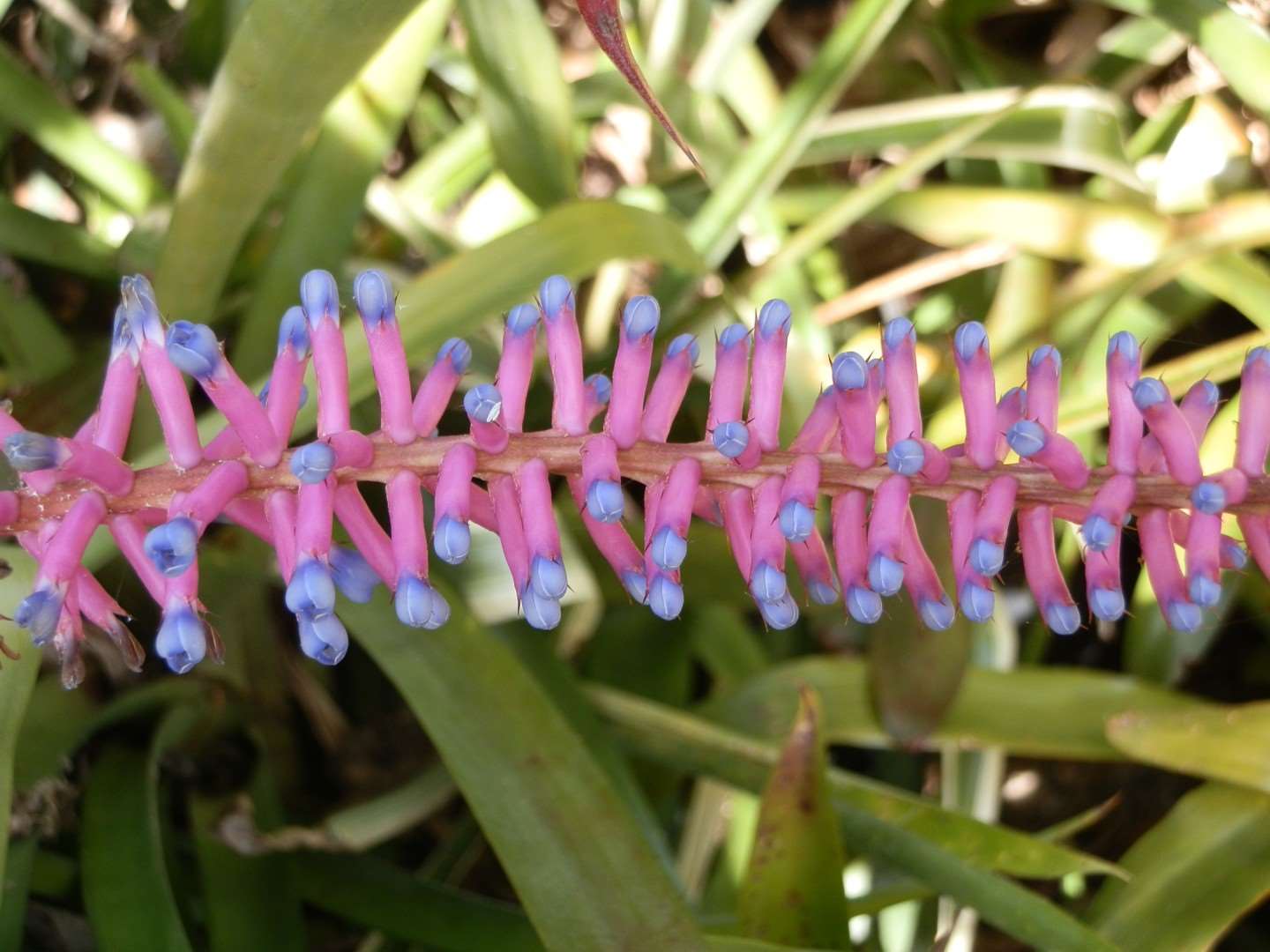
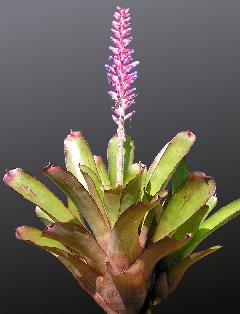
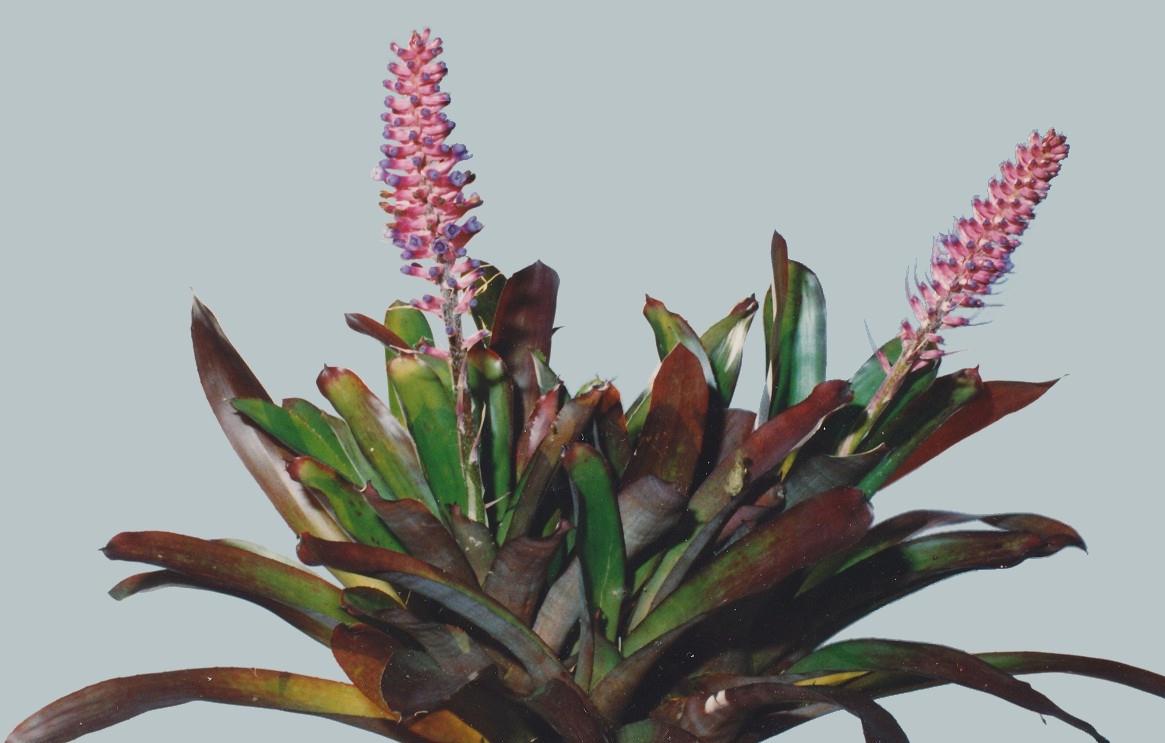
Aechmea gamosepala var gamosepala
Aechmea gamosepala var angustifolia Wittmack, Bot. Jahrb. 13(Beibl. 29): 13. 1891. Type. Left bank of Rio Itajai. Itajai, Santa Catarina, Brazil, Schenck 1257 (B n v).
Aechmea thyrsigera sensu Mez, Pflanzenreich IV. 32: 95. 1934; non Spegazzini, 1917.
Sepals red; petals purple or blue.
Type. Schimper 231 (holotype, LG n v), Joinvile, Santa Catarina, Brazil.
Distribution. From terrestrial on dune slopes to epiphytic in forest, from near sea level to 250 m alt, Sao Paulo to Rio Grande do Sul, Brazil.
BRAZIL. Sao Paulo: Sao Paulo, 13 Jul 1933, Ostermeyer s n (SP). Parana: Guaratuba, 2 Oct 1929, Hoehne s n (SP); Jul1951 , Frenzel s n (IBP); 3 Feb 1952, Reitz 4272 (HBR); 21 Feb 1952, L. B. Smith & Reitz 5734 (R, US); Caioba, Paranagua, Aug 1939, Foster 439 (GH, R); 4 Nov 1947, Tessmann s n (US); 1 Nov 1949, Hatschbach 1854 (MBM, US); north of Joinvile (Santa Catarina), 14 Jan 1951, Reitz 3891 (HBR); Ventania, 22 Oct 1962, A. Seidel s n (HBR). Santa Catarina: Joinvile, 26 Aug 1897, Schwacke 13359 (P); Jan 1951, Reitz 3726 (HBR); 3881 (HBR); Itapocu, 4 Sep 1897, Schwacke 13369 (RB); Sombrio, 27 Jul1944, Reitz C-642 (GH, HBR); 3 Sep 1945, C-1222 (HBR, US); Sao Francisco do Sul, Sep 1950, Reitz 3675 (HBR); Jan 1951, 3729 (HBR); 3913 (HBR); Barra do Sul, Araquari, Reitz & Klein 508 (! Reitz); Itajuba, 11 Jan 1951, Reitz 3758g (HBR); Sanga da Areia, Jacinto Machado, 4 Sep 1959, Reitz & Klein 9034 (HBR, US). Rio Grande do Sul: Torres, 21 May 1893, Golland s n (S); Taimbe, Sao Francisco de Paula, 21 Feb 1951, Rambo s n (US).
Aechmea gamosepala var nivea Reitz, Sellowia 14: 101. 1962.
Sepals rose; petals white.
Type. Reitz & Klein 9093 (holotype, HBR), terrestrial in woods, Pirao Frio, Sombrio, 10 m alt, Santa Catarina, Brazil, 5 Sep 1954.
Distribution. Known from the type collection only.
8a - AECHMEA GAMOSEPALA Wittmack var. GAMOSEPALA by Reitz in Bromeliaceas E A Malaria 400-404. 1983
Wittmack, Bot. Jahrb. 13 (Beibl . 29):3, 13. 1891; Reltz, Anais Bot. Herbario Barbosa Rodrigues 2: 9. 1950, op. cit. 3: 98. 1951, op. cit. 4: 37. 1952, op. cit. 4: 49. 1952, Sellowia 7: 126. 1956, op. cit. 13: 79. 1961, op. cit. 17: 45. 1965, op. cit. 19: 101. 1967, Anais XV Congr. Nac. Bot. 237. 1967; L. B. Smith & R. J. Downs, Flora Neotrop. 14 (3): 1884, fig. 642 A-E. 1979.
Aechmea gamosepala var. angustifolia Wittmack, Bot. Jahrb. 13 (Beibl. 29):13. 1891.
Aechmea thyrsigera sensu Mez, Pflanzenreich IV. 32: 95. 1934; non Spegazzini, 1917.
EPIPHYTIC, or rupicolous terricolous, acaulis, stoloniferous, flowering, 0.4-0.8 m in height.
LEAVES 15-20, arranged in a dense rosette, and gathered at the bottom forming tank;
SHEATH evidently amplexicaule, 20 cm long, 7.5 cm wide, edges brown-membranaceous, amplexicaule, scales on both sides, entire, yellowish white underneath, brown soon afterwards, purple in the middle and green towards the tip;
BLADES suberect, subcartaceous, channelled-concave, margins unarmed, but with a few small spines near the tip, light green, not narrowed at the sheath, rounded at the tip, with a mucron almost not pungent, subglabrous at top, scaled towards the base, more or less narrow or largely linear, 0.40-0.60 m long, 2.5-3.5 cm wide.
INFLORESCENCE indefinite axis, ending with a sterile tuft of bracts at the tip, taller than the leaves, simple spike, 40-100-flowered or more, sylindrical, erect or curved, truncated at the top, 4 cm. diam, with flowers sublaxly disposed, sessile, suberect before anthesis, reflexed at anthesis;
SCAPE erect, slender, 4-6 mm diam., subglabrous, slightly white lanuginose, cylindrical;
SCAPE BRACTS deciduous, the lower ones semi-amplexicaule, the upper ones 1/4 amplexicaule, lanceolate-acute, entire, a few scales on the back, the upper ones red, the remaining straw coloured, erect;
RACHIS reddish-green, very wrinkled, a little lanuginose;
FLORAL BRACTS red, ovate-lanceolate or lanceolate, with a tip pointed filiform, the lower ones larger than the corolla, the middle ones and above shorter than the calyx, entire.
FLOWERS more or less 20mm long, sessile;
SEPALS connate a little above half the cylindrical tube in a continuation from the ovary, 5 mm long (without the spine), later free, convoluted, assymetric, with obvious wing on the right side, tip rounded, with a spine 4 mm long, glabtous;
PETALS 12 mm long, free to the base, erect at anthesis, a little opened, genitalia included, widely linear passing to an obtuse blade and hooded concave, with 2 LIGULAS l mm above the base, edges fimbriate, without calluses;
STAMENS l mm smaller than the petals;
FILAMENTS flat linear, wide, narrow toward the base, interpetalous ones completely free, epipetalous ones adnate for 6 mm to the petals;
ANTHERS in a ring, narrow linear, both sides a little long acute, affixed near the middle;
POLLEN GRAINS biporate, regular;
OVARY glabrous, sub-stipitiform-cylindric, 8 mm long, 4 mm diam., reddish purple;
EPIGYNOUS TUBE large (3 cm long), infundibuliform;
STYLE filiform, smaller than the stamens;
STIGMA lobes contorted spirally;
PLACENTA more or less affixed at the middle in the internal angle of the locules;
OVULES numerous, horizontally affixed, obtuse.
BERRY wine color when immature, black when ripe, formed slightly larger than the ovary.
SEEDS numerous, small (1.5 mm), chestnut brown.
Type-Brazil, Santa Catarina: Joinville, Schimper 231 (LG holotype).
Phenology – Was found in flower in the months of April, May, June, July, August, September and December; with ripe fruits in January.
Ecological observations: Epiphytic herb, or rupicolous or terricolous, stoloniferous, 40 to 100 cm tall. Leaves arranged in a dense rosette funnel, forming a tank at the base; sheaths distinct, amplexicaul; Blades suberect, subchartaceous, channelled-concave, the edges unarmed, but with few and small spines near the apex, light green and not narrowed at the sheath, apex rounded, subglabrous at the top, with a not particularly pungent mucron, narrow or wide linear, at the middle 2.5-3.5 cm wide, 40 to 60 cm. long, not surpassing the basal flowers of inflorescence; inflorescence a simple spike, tubular densifloral with 40 to 100 sessile flowers, sepals purplish red, petals purple or blue; characteristic and exclusive to Atlantic rain forest in southern Brazil, where it is spread far and wide, but discontinues with irregular dispersal, across the "Porta de Torres" in the State of Rio Grande do Sul, having possibly a southern limit in the Vale do Maquine, in the municipality of Osorio.
Species of diffused light or heliophytic, it selects communities next to the sea (restinga and forests of the fourth generation plains), where it is sufficiently frequent, forming large groups, more rarely within the forests of the slopes, eventually reaching the plateau, penetrating to the cloud forests of pines and small trees. Found from almost sea level to 1,200 m altitude. The vast majority of these grow on the humus of the restinga and the remainder on the trunks of trees.
I have always had difficulty in reconciling the drawing in Smith & Downs with what we grow as A. gamosepala. The drawing appeared in 1892 and while the flowers may be called lax you cannot easily discern the matchstick flowers that are much further apart these days! I had always tried to identify an A. gamosepala from an A. cylindrata by the fact that A. cylindrata had a much denser inflorescence. Alas, this method does not work if we use the key in Smith & Downs which reads as follows:
18. Inflorescence with its axis slightly exposed, many-flowered.
- - 20. Flowers 20 mm long; inflorescence stout; floral bracts soft. => cylindrata
- - 20. Flowers 15 mm long; inflorescence slender; floral bracts pungent. => gamosepala
You have to decide if the floral bract which is the insignificant papery thing immediately below each flower, is soft or sharp!
But when we read Reitz in his Flora Illustrada Catarinensis 1983 we find that petals can be 20mm long for A. gamosepala. We must remember that Santa Catarina is where the type specimen was found but not seen by Smith. Another thing missing in the Smith & Downs description is that A. gamosepala is stoloniferous – some with short stolons, some long. The following is what we should be using for identification:
Aechmea gamosepala Wittmack, Bot. Jahrb. 13(Beibl. 29): 3, 13. 1891.
Description from Smith & Downs
Plant flowering 40-75 cm high. (stoloniferous)
Leaves 15-20 in a dense funnelform rosette, 25-55 cm long, covered with pale minute appressed scales especially beneath, nearly entire or with a few minute spines near apex;
Sheaths narrow but distinct, sometimes tinged with blue;
Blades ligulate, broadly rounded and apiculate, 3-5 cm wide.
Scape erect, slender, sparsely white-flocculose, soon glabrous;
Scape-bracts erect, lanceolate or elliptic, acute, entire, membranaceous, deciduous.
Inflorescence simple, slenderly cylindric, obtuse, sublax, 9-26 cm long;
rhachis slender, glabrous or nearly so.
Floral bracts narrowly triangular, attenuate, pungent, entire, nerved, the lower exceeding the flowers, the upper shorter than the ovary;
Flowers sessile, spreading or suberect, 15 mm long.(20mm long)
Sepals strongly asymmetric, rounded, 4-5 mm long without the 2.5-4 mm spine, halfconnate, glabrous;
Petals erect, ligulate, obtuse, 9 mm long, purple or blue, bearing 2 fimbriate scales near base;
Stamens included;
Ovary slender, narrowed toward base; epigynous tube large, crateriform; placentae central; ovules obtuse.
Aechmea gamosepala var gamosepala
Sepals red; petals purple or blue.
Type. Schimper 231 (holotype, LG n v), Joinville, Santa Catarina, Brazil.
Distribution. From terrestrial on dune slopes to epiphytic in forest, from near sea level to 250 m alt, Sao Paulo to Rio Grande do Sul, Brazil.
Aechmea gamosepala var nivea Reitz, Sellowia 14: 101. 1962.
Sepals rose; petals white.
Type. Reitz & Klein 9093 (holotype, HBR), terrestrial in woods, Pirao Frio, Sombrio, 10 m alt, Santa Catarina, Brazil, 5 Sep 1954.
Distribution. Known from the type collection only.
I will now mention a few of the names as being part of the Gamosepala Group. There are currently 12 of these.
One trait that is readily noticed as being different to the species involves variegation. In J. Brom. Soc. 55(4): 187-9. 2005 I pointed out that we should only accept one variegated form per species to save confusion. Here we have problems with 'Lucky Stripes' and 'Mardi Gras' where difference is said to be in the darkness of the green in the leaf which can be easily picked up if the plants are grown side by side. If not, you can have problems. Then there was the case of a plant that became variegated in Brazil. Should it have a name? Do we use 'Lucky Stripes' or 'Mardi Gras'? We decided to leave it as A. gamosepala 'Variegated'.
The other variegate is 'Exotica Candy Stripes' but this has almost white petals.
This renewed interest caused Australian growers to look at plants they had been growing for years and there were definite forms being grown that were different to the 'norm', one with long stolons – generally called 'with stolons', and another with reddish leaves called 'Rubra'
Recently we have seen registered
1. Aechmea 'Big Pinkie'
A large form of gamosepala named by Ross Little, NSW. Origin unknown. Fertile part of inflorescence to 35cm long. No apparent stolons.
2. Aechmea 'Ruby Red', named by Ross Little, NSW, for a plant that has been circulating Australia for over 20 years as A. gamosepala Rubra. Grown at least by Ruby Ryde and Nina Rehak in Sydney and Bernard Stonor in WA. Leaves redder, wider and stiffer than the ‘normal’ A. gamosepala. Plant to 30cm high, to 60cm when in flower.
3. Aechmea ‘Big Matchsticks’ named by Geoff Lawn, WA, Mature rosette to 50cms. diameter x 60cms. high. Erect spike to 1 metre tall. Lengthy stolons to 50cms. Flowers are paler than "normal" gamosepala. This clone has been circulating in Australia for over 20 years as "gamosepala big form", or “With stolons”
4. Aechmea 'Red Lips' Named by Ross Little, NSW.
A form of A. gamosepala with red leaf edges. Grown for many years at Pinegrove Nursery as just another A. gamosepala but differs in several ways. Plant smaller than 'Big Matchsticks' but still with stolons. The scape is reddish and the fertile part of the inflorescence somewhat disappointing at only around 13cm long and 3 cm wide.
We know that 'lots' of gardeners grow Aechmea gamosepala even if they don’t know the name! So if the keen ones amongst you who look for differences happen to come across some unnamed plant which flowers like A. gamosepala remember that they come with different names for the different forms. If you come across yet another form please let me know.